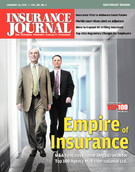Coastal Alabama should seize the BP Gulf oil disaster as an opportunity for “resiliency planning” that will not only help the region recover from the oil damage but also put it in a position to better recover from any future disasters, whether natural or manmade, according to a sweeping report from a special commission.
The report from the Alabama Coastal Recovery Commission, entitled “A Roadmap to Resilience,” makes a case that risk management initiatives and private insurance markets are vital to this resiliency planning.
“Despite the volatility of the debate over what’s fair in regards to coastal insurance affordability, the bottom line is that somebody is going to pay the bill for the degree of risk the industry is willing to take,” the report says.
The report contains numerous risk management and insurance recommendations including that the state strengthen its building code; find ways to attract new property insurers; encourage the sale of multi-year policies; require that multi-peril policies show the separate premiums charged for wind and non-wind portions of policies; and that the state enact tax-free funds to help homeowners save for the cost of insurance deductibles and mitigation measures.
The plan calls for improving the claims process for people and businesses affected by the BP oil disaster and making sure any monies collected from BP or the government are spent where they will do the most good.
But it also goes beyond addressing immediate claims and financial needs to recommending broad efforts to restore South Alabama’s beaches and the barrier islands; boost the state’s seafood and tourism industries; and improve education, public safety and public health so that the recovery is sustainable.
The commission, launched by Gov. Bob Riley and hundreds of community leaders, collected testimony for 90 days.
According to the commission, the BP oil spill is more than a temporary threat to Gulf coastlines; it is a catastrophe that may take decades to measure. The solution, the commission says, is for south Alabama to build regional capacity for long-term resilience. “We must position ourselves to respond not only to future oil spills but also to other forces beyond our control, including everything from hurricanes to sudden shifts in the economic environment,” the report states.
The report describes the insurance market on the coast since Hurricanes Ivan and Katrina as “unsustainable,” one where demand for insurance has far exceeded the supply. It is a market consisting of small regional insurance companies and one with little competition. The biggest problem is the lack of availability of wind coverage, which is forcing homeowners to obtain coverage though the insurer of last resort, the Alabama Insurance Underwriting Association, or from high-priced surplus lines insurers. The number of homeowners with wind pool policies under the AIUA has grown since Ivan, from about 3,500 policies to 18,865 as of Oct. 31. Many homeowners are simply going without coverage, according to the report.
Alabama should refrain from subsidizing the rates charged by the AIUA pool, according to the commission, which cites problems with the Florida insurance market and the federal flood insurance program where governments have subsidized rates.
“If the overriding policy goal is to foster a competitive private market and give consumers more choice, subsidizing policies with taxpayer dollars should not be considered a viable, long-term option,” the report says.
Topics Energy Oil Gas Homeowners Alabama
Was this article valuable?
Here are more articles you may enjoy.


 Beryl’s Remnants Spawned 4 Indiana Tornadoes, Including an EF-3: NWS
Beryl’s Remnants Spawned 4 Indiana Tornadoes, Including an EF-3: NWS  Travelers Reverses Q2 Income Loss, Narrows Underwriting Loss
Travelers Reverses Q2 Income Loss, Narrows Underwriting Loss  AIG Files Amended Suit Against Former Execs, Dellwood Insurance
AIG Files Amended Suit Against Former Execs, Dellwood Insurance  Soccer Officials Arrested After Melee That Damaged Hard Rock Stadium in Miami
Soccer Officials Arrested After Melee That Damaged Hard Rock Stadium in Miami 


